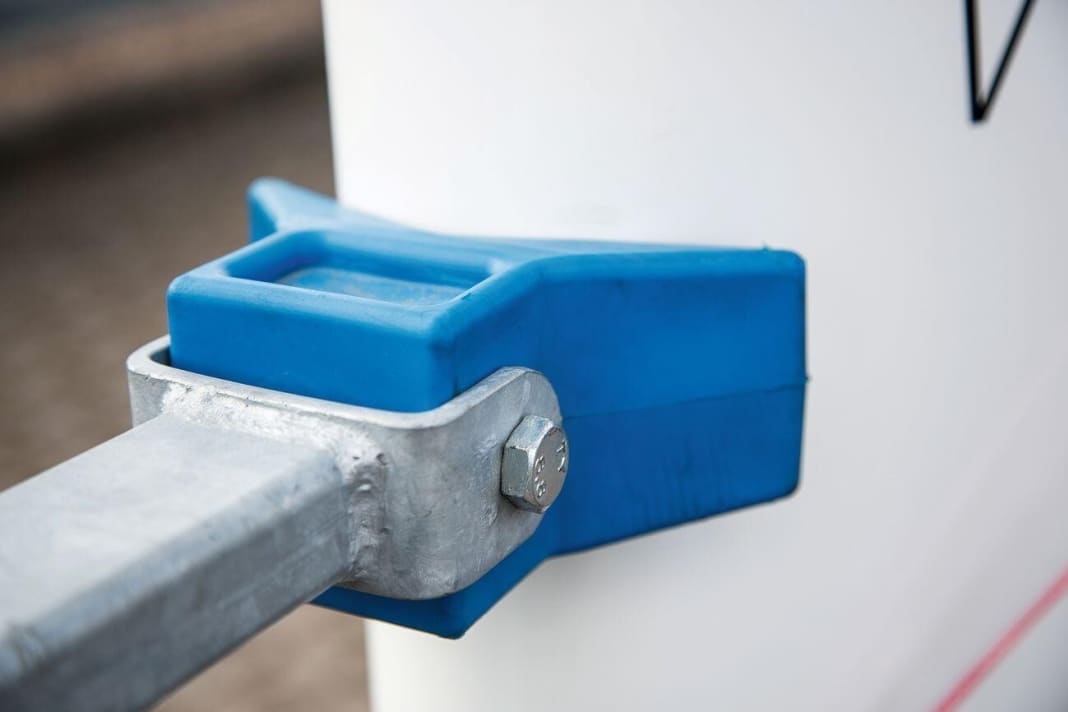





There are no regulations on exactly how a boat must be secured on the trailer. However, the law requires that it remains secured during all conceivable driving manoeuvres. This includes emergency braking or sudden evasive manoeuvres. Lashing straps with ratchets should be used for lashing. Hemp or textile ropes are not permitted, nor are knotted fasteners, as their holding force cannot be calculated. The holding force of each individual strap used should be at least half the weight of the boat.
A combination of vertical and diagonal lashing has proved its worth: the vertical straps at the bow and stern press the boat into the supports and increase the friction on these, which reduces the movement of the boat on the trailer. This is particularly important when using rollers as supports. The vertical straps also secure the boat in the event of lateral movements.

This article is part of a trailer special:
Diagonal belts absorb the forces during braking and acceleration
The diagonal belts should be fitted at an angle of approximately 45 degrees. They primarily absorb the forces when braking or accelerating. The more individual straps are used, the better, as they share the forces. The attachment points on the trailer should be offset for the same reason. Do not cut off the labels on the straps and ratchets - they serve as proof of sufficient holding force during inspections.
Tighten the straps, ratchet to the right-hand side
If the straps are routed continuously across the boat, their tension is higher on the side with the ratchet than on the opposite side. This normally evens out during the journey. Therefore, check the straps after a few kilometres and tighten them if necessary. Therefore, always fit the ratchets on the right-hand side. This way, you can simply pull over to the right and tighten them if necessary and are not on the left-hand side of the vehicle, which is dangerous due to oncoming traffic.
Twist in belts to prevent swinging open
Belts that are tensioned downwards can vibrate in the wind and start to sing. This is not only an annoying noise, but can also lead to chafing on the torso if the vibrating belt touches it. To avoid this, the belt can be turned in half a turn or a full turn.
Position the boat in the centre
Before lashing, however, the boat should be correctly positioned on the trailer. This means straight and with its centre of gravity as close as possible to the axle. Then check the drawbar load. This can be found in the vehicle registration document; it should be utilised as fully as possible for better handling, but should never be exceeded.
Place keelboats on the keel
Boats with a keel should stand on the keel; the supports only serve to absorb lateral forces. Their supports should have a large surface area to avoid point loads on the hull. Large-area half shells have also proved effective as supports. Movements are minimised due to the positive fit. However, owners like to equip them with non-slip pads for easier slipping. This is counterproductive during transport unless anti-slip mats are placed in between.
Also secure the load
You should only rely on the bow support and winch to secure the boat if it is designed for this purpose according to the manufacturer's instructions. Sometimes it only serves as a slip aid. Securing the load is just as important as securing the boat itself. Secure not only the mast, but also objects in the boat! Fuel tanks may be fully filled if they are permanently installed; loose tanks up to a maximum of five litres. As a general rule, it is better to empty all tanks, as this reduces the weight of the trailer and improves handling characteristics.
Do not exceed the trailer load
If you are unsure about the trailer load, check it on the scales. The weighing cards issued can also be helpful during a police check. The load, usually the mast, may protrude up to 1.50 metres beyond the light bar at the rear. If the outermost end of the load protrudes more than one metre beyond the rear reflectors of the vehicle, it must be clearly marked.

